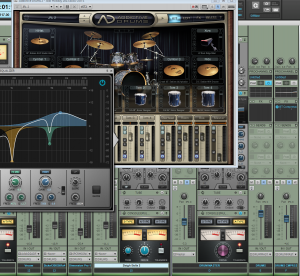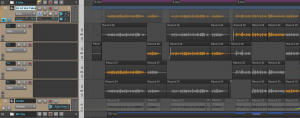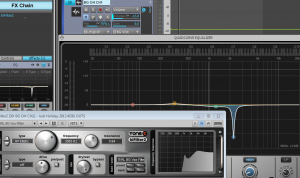 “Audio Production Jobs” come in all shapes and sizes these days;-) Yes, the music industry in general has shrunken to an all-time low in terms of major label budget projects, but the flip side is that there are many nooks and crannies out there to stay creative while making money. I think the key these days is getting into as many industry circles as possible, and then over-delivering. If you’re handed a job for writing, mixing, producing or even recording, and you knock it out of the park the first time with low-no hassles to the client, you will certainly come to mind on the next round. I would also be willing to bet that your name will be referred to other folks outside of that job’s “circle.” You just never know to where things are going to lead.
“Audio Production Jobs” come in all shapes and sizes these days;-) Yes, the music industry in general has shrunken to an all-time low in terms of major label budget projects, but the flip side is that there are many nooks and crannies out there to stay creative while making money. I think the key these days is getting into as many industry circles as possible, and then over-delivering. If you’re handed a job for writing, mixing, producing or even recording, and you knock it out of the park the first time with low-no hassles to the client, you will certainly come to mind on the next round. I would also be willing to bet that your name will be referred to other folks outside of that job’s “circle.” You just never know to where things are going to lead.
Stemming from this theory, I have been fortunate enough to work on some pretty diverse projects ranging from title tracks for Pokémon DVD’s to Major Label artists and just about everything in between in one form or another. For the work I do now, the one thing that gives me an edge using SONAR X3 Producer over other DAWs is the quickness of the workflow; which contributes to music creation diversity. Sounds deep right? …well it kind of is. Here’s a real-world example with italicized words in red representing why SONAR X3 features are crucial to me when facing tough audio jobs.
 Just a few weeks ago I was contacted by NYC singer-songwriter Jodi Good’s music attorney Steven Beer on a Friday night to discuss an opportunity for a “Holiday Song” to be placed with a major publication [for Monday]. Now usually, “Holiday Songs” are recorded around August or September and we were already at the end of November, so I knew this was going to be a tough one to accomplish especially since the song had to be written, recorded and mixed fast. The other strike against me was that this one was a bit out of my rock, and pop-rock comfort zones, but I knew the challenge would be a good experience on many different levels, so I decided to fire up the eggnog and go for it. Plus I had the comfort of knowing that Jodi is a great songwriter especially in the lyric department, so it was “weekend on.”
Just a few weeks ago I was contacted by NYC singer-songwriter Jodi Good’s music attorney Steven Beer on a Friday night to discuss an opportunity for a “Holiday Song” to be placed with a major publication [for Monday]. Now usually, “Holiday Songs” are recorded around August or September and we were already at the end of November, so I knew this was going to be a tough one to accomplish especially since the song had to be written, recorded and mixed fast. The other strike against me was that this one was a bit out of my rock, and pop-rock comfort zones, but I knew the challenge would be a good experience on many different levels, so I decided to fire up the eggnog and go for it. Plus I had the comfort of knowing that Jodi is a great songwriter especially in the lyric department, so it was “weekend on.”
Literally that night Jodi was sending me vocal-only words and melodies as text messages on my Samsung S4. She doesn’t play an instrument and we didn’t have the benefit of time, so we had to start writing via virtual and digital means. I instantly forwarded them via email to my HP Z400 main rig where I drag-and-dropped them into a session for reference where they automatically created audio tracks. The next move was simply pulling them down to a midi track where Melodyne’s ARA technology kicked in instantly giving me the notes in Midi. This helped me to figure out the best chord structures for the verses and pre-chorus and also allowed me to see where I could go writing the chorus melody. After about a half hour on my trusty acoustic, I had the bones to send back to Jodi via text.
[I’m going out on a limb here for your laughing pleasure 😉 Here’s the actual writing file on my phone which is what I texted back to Jodi when we were writing the melody – so you can hear how the song started, and where it ended.]
RESULT AFTER RECORDING, PRODUCING, MIXING IN SONAR X3 PRODUCER IN 24 HOURS FROM WRITING IDEA TO DELIVERY:
The next day I started to get the drums going before Jodi came over to work out the rest of the song with me. Using SONAR’s Track Template feature, I simply drag-and-dropped one of my Addictive Drums templates onto the Track View where it gave me 13 tracks already routed to separate outputs and busses. I also had send-signals going from each track to a  separate bus for parallel compression and my EQ’s for all the drums were already in place [as starting points] in this template as well, so now it was just a matter of finding grooves and tailoring the Midi. This process alone would have taken me at least a good hour to setup, but in SONAR you’re able to use these templates to save a ton of time. And the great thing is that the more you use Track Templates, the more your library grows with them.
separate bus for parallel compression and my EQ’s for all the drums were already in place [as starting points] in this template as well, so now it was just a matter of finding grooves and tailoring the Midi. This process alone would have taken me at least a good hour to setup, but in SONAR you’re able to use these templates to save a ton of time. And the great thing is that the more you use Track Templates, the more your library grows with them.
Next I started on recording the acoustic guitars. This track called for more of traditional “organic” and acoustic style instrumentation, so again I dragged in one of my acoustic guitar templates which entailed 4 tracks. The great thing about these track templates is that they create busses for Ddyou and remember all the parameters including input routing. So for example, these 4 tracks are comprised of MIC 1 AND MIC 2 and automatically routed them respectfully to INPUT 1 and 2 of my TASCAM DA-3000 [I just got this and it’s killer by the way – awesome converters!].  These tracks are automatically sent to an “Acoustic Bus” which was automatically created in the template. And further, the template automatically created sends to ambiance reverb busses using Breverb. There are a lot of “automatically’s” in the previous sentence, but that’s just it; using Track Templates like this literally saves me hours and enables me to pull off productions in ½ the time. I use these templates for all instruments and vocals and it saves me from having to create and route over 50 tracks and 20 busses with various instruments individually.
These tracks are automatically sent to an “Acoustic Bus” which was automatically created in the template. And further, the template automatically created sends to ambiance reverb busses using Breverb. There are a lot of “automatically’s” in the previous sentence, but that’s just it; using Track Templates like this literally saves me hours and enables me to pull off productions in ½ the time. I use these templates for all instruments and vocals and it saves me from having to create and route over 50 tracks and 20 busses with various instruments individually.
Once I got the drums, bass and acoustic guitar beds down, Jodi and I went to work on the vocals, but we didn’t have a lot of time considering her schedule. Again using Track Templates I had all my tracks set up to go > Lead Vocal, Lead Vocal Double, and 6 tracks of Background Vocals. With SONAR X3’s new Comping feature, I took roughly 4 performances of each part of the song and was able to quickly compile a  “master lead performance-take” in no time at all. This is very significant, because I was able to put together a master comp so fast that we were able to track backing vocals over the actual comp. In the past when working under time constraints, I would often have to track backing vocals over one of the random takes which would result in a lot of editing after-the-fact. Because Jodi was able to match her backing vocals directly to the intricacies of the actual lead-take being used, I was freed up to work on making the overall production better in the time allotted.
“master lead performance-take” in no time at all. This is very significant, because I was able to put together a master comp so fast that we were able to track backing vocals over the actual comp. In the past when working under time constraints, I would often have to track backing vocals over one of the random takes which would result in a lot of editing after-the-fact. Because Jodi was able to match her backing vocals directly to the intricacies of the actual lead-take being used, I was freed up to work on making the overall production better in the time allotted.
After listening to a few “Holiday Songs,” I identified a few common traits and went after them in the recording process. One of those traits was a light and airy piano with staccato-like hits, and then other was a combination of tambourines and bells. SONAR X3 Producer’s Lounge Lizard combined with the ProChannel gave me the exact sound I was looking for on the piano side of things [you’ll hear the double piano hits in the chorus way in the background to give it an inconspicuous lift combined with the tambourine]. For the tambourine and bells, I used  Dimension Pro “Sleigh Bells” and was easily able to compress and EQ a great sound that was evident, but didn’t get in the way. The great thing about the ProChannel is that it’s incredibly fast to get the sound you’re looking for and especially now with the new fly-out and analyzer. Having the ProChannel in the Skylight’s Inspector also allows me to combine the use of the Track View’s automation lanes with the ease of tweaking ProChannel parameters at the same time – I can see it all in one view.
Dimension Pro “Sleigh Bells” and was easily able to compress and EQ a great sound that was evident, but didn’t get in the way. The great thing about the ProChannel is that it’s incredibly fast to get the sound you’re looking for and especially now with the new fly-out and analyzer. Having the ProChannel in the Skylight’s Inspector also allows me to combine the use of the Track View’s automation lanes with the ease of tweaking ProChannel parameters at the same time – I can see it all in one view.
Another trick I have found useful in SONAR X3 Producer is using the BiFilter2 for backing vocals. This effect is really versatile when you explore all of its sounds. I have a few presets that I designed that give the vocals a bit of distortion while filtering out the lows and some of the mids. Getting backing vocals to sit correctly can be tough and it’s  always a different combination of effects and tools depending on diction, words, other instruments in that frequency range; and what the song calls for as well. If you listen closely to the verses on this track, you will notice that I have backing vocals going all the time, but they are not super-evident. The background vocal melody I came up with for these verses gave it a nice new flavor, but we both agreed we didn’t want them to be too conspicuous, so I used the BiFilter2 to get them to sit correctly, and also kept them close to the middle until the chorus.
always a different combination of effects and tools depending on diction, words, other instruments in that frequency range; and what the song calls for as well. If you listen closely to the verses on this track, you will notice that I have backing vocals going all the time, but they are not super-evident. The background vocal melody I came up with for these verses gave it a nice new flavor, but we both agreed we didn’t want them to be too conspicuous, so I used the BiFilter2 to get them to sit correctly, and also kept them close to the middle until the chorus.
Finally before mixing, I concentrated on writing an airy guitar part for the verses and Chorus. This part had as much to do with the tone I got from TH2 as with the part and performance itself. SONAR’s TH2 is a top-of-the-line guitar tone simulator that gives you professional results quickly. It’s almost as if the tone I got dictated the performance and choice of notes – I love it when that happens. Again, I didn’t want to have anything too overbearing, so I elected to go with a light and airy T-bone Burnett type of arpeggiated flavor to give the verse a lift without getting in the way. I used one of the tones from the TH2 “Building Blocks” presets for this part.
 One more noteworthy component to this SONAR X3 Producer project was the ease of finalizing my mix. In my opinion, the treatment of effects on the master bus can be just as important as the mix itself, and I must say that I have fallen in love with a syrupy concoction of the BlueTubes Limiter, PC4K Bus Compressor and the LP64 EQ. I actually have a few variations of this chain saved as a Track Template and FX Chain Preset as well inside the ProChannel itself. Having the Analyzer now integrated into the QuadCurve EQ really allows me to combine my ear with a detailed view of the frequencies; greatly helping my overall mix especially above 3k.
One more noteworthy component to this SONAR X3 Producer project was the ease of finalizing my mix. In my opinion, the treatment of effects on the master bus can be just as important as the mix itself, and I must say that I have fallen in love with a syrupy concoction of the BlueTubes Limiter, PC4K Bus Compressor and the LP64 EQ. I actually have a few variations of this chain saved as a Track Template and FX Chain Preset as well inside the ProChannel itself. Having the Analyzer now integrated into the QuadCurve EQ really allows me to combine my ear with a detailed view of the frequencies; greatly helping my overall mix especially above 3k.
So between track templates, FX Chains, X3 instruments and effects, ProChannel presets and the quickness of the Skylight Interface, I was actually able to deliver this track early (3am Sunday morning) which freed me up to do something else on Sunday… WATCH FOOTBALL! On Monday morning I got the word from Jodi’s music attorney that the track was accepted with no edits where it now lives on Glitter Magazine (yep – I told you in the beginning of this blog that “Audio Production Jobs come in all shapes and sizes these days,” and I’ll take what I can get! 😉
Thanks for reading.

